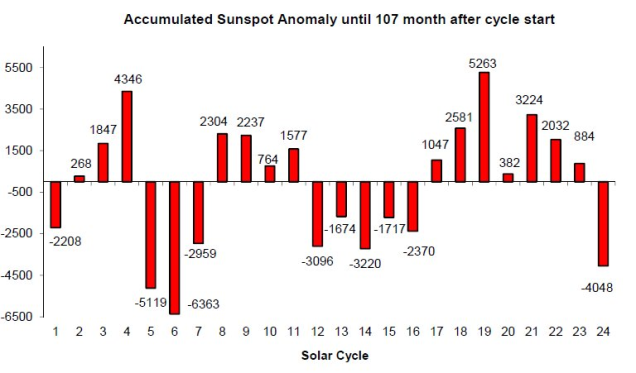by Meteorologist Paul Dorian, Vencore, Inc.
Overview
Solar cycle 24 has turned out to be historically weak with the lowest number of sunspots since cycle 14 peaked more than a century ago in 1906 and by some measures, it is the third weakest since regular observations began around 1755. This historically weak solar cycle continues a weakening trend in solar irradiance output since solar cycle 21 peaked around 1980 and the sun is fast-approaching the next solar minimum. The last solar minimum lasted from 2008 to 2009 and the sun was as quiet during that time as it has been since 1978. The sun is likely to enter the next solar minimum phase within three years or so. The sun has been spotless for 26% of the time in 2017 (90 days) and the blank look should increase in frequency over the next couple of years leading into the next solar minimum.
The importance of the sun
The sun is the main driver of all weather and climate on Earth and without it, life on Earth would not exist. The sun’s output energy is not constant, however, as it varies over the course of about 11 years which is the average time period of a solar cycle (a.k.a., sunspot cycle), typically taking about 5 1/2 years to move from the quieter period of solar minimum to the more turbulent solar maximum phase. Over the course of one solar cycle, the sun’s emitted energy varies on average by about 0.1 percent. That may not sound like a lot, but the sun emits a large amount of energy – 1,361 watts per square meter – and fluctuations of just a tenth of a percent can affect Earth.

The accumulated sunspot anomaly from the mean of the previous 23 cycles – 107 months into the cycle. Source
Third weakest solar cycle since 1755
Solar cycle 24 began in 2008 which puts us about nine years into the current cycle. An analysis of the current solar cycle (#24) finds it to be the third weakest since 1755 in terms of accumulated sunspot number anomalies from the mean value at this stage of the solar cycle. The mean value is noted at zero and solar cycle 24 is running 4048 spots less than the mean at the time of the study. In fact, the researchers claim that there have been only two weaker cycles since systematic observations began in 1755 – solar cycle 5 which began in April 1798 and solar cycle 6 which ended in May 1823 – both of these occurred during the extended period of low solar activity known as the “Dalton Minimum”. The seven cycles preceded by solar cycle 24 actually had more sunspots than the mean.
The rest of the Article is HERE. Dorian discusses the decline in solar irradiance over the last 40 years and new Space Station energy sensors.
Reblogged this on Tallbloke's Talkshop and commented:
History suggests extended quiet periods on the Sun do have consequences on Earth, so it will be interesting to see how things play out over the next few years and beyond. Watch out for the length of this solar cycle as well, following a run of shorter than average cycles in the last 100 years or so.
tes
Reblogged this on Climate Collections.
The true factor not mentioned is that our magnetoshphere intensity relies on the solar disturbances.
In times of low solar activity our planet is bombarded with deep space particles causing magmic increases specifically in high silica volcanic systems. Ergo massive volcanic and techtonic activity…
Its gonna be a bumpy ride folks
Good article. Unfortunately, it leaves out the mechanism by which sunspot count and the sun’s magnetic field create cooling and climate worsening. lower solar magnetic field, weaker solar wind, more cosmic rays, more cloud nucleation. The effect of the reduction in TSI alone is minimal and an easy target for the “anthropogenic climate change” mob.
Can someone on your team please answer these questions.
1) Sunspot activity represent magnetic activity. Therefore the sun is a giant electro-magnet. The earth is also an electro-magnet. As Michael Faraday proved magnetism is stored electricity and when a large electro-magnet shuts down it induces an increase in electricity in a nearby electromagnetic coil. In other words if the Sun which has been very magnetic over the Grand Maximum were to suddenly shut down it would induce an increase in electricity in the earth’s magnetic field and this would in turn result in increased heating at the core of the earth.
Question 1
Is there a connection between the Sun’s electromagnetic shut-down and the increased activity in the “Ring of Fire”. We are now getting something like the equivalent 40 years activity at the “Ring of Fire” in just one year.
Question 2
Is there a connection between “Ring of Fire” activity and the “el Nino” effect?